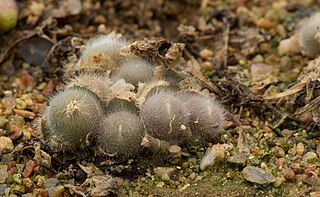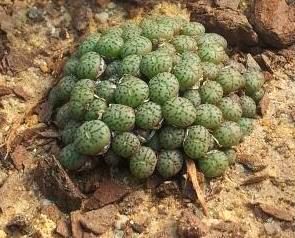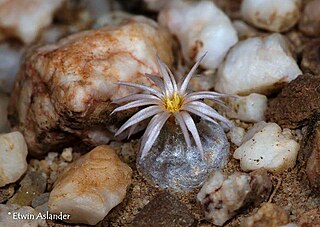A storage organ is a part of a plant specifically modified for storage of energy (generally in the form of carbohydrates) or water. Storage organs often grow underground, where they are better protected from attack by herbivores. Plants that have an underground storage organ are called geophytes in the Raunkiær plant life-form classification system. Storage organs often, but not always, act as perennating organs which enable plants to survive adverse conditions.

Bergerocactus emoryi is a species of cactus, known commonly as the golden-spined cereus, golden snake cactus, velvet cactus or golden club cactus. It is a relatively small cactus, but it can form dense thickets or colonies, with the dense yellow spines giving off a velvety appearance when backlit by the sun. From April to May, yellow, green-tinged flowers emerge, which transform into reddish, globular fruit. This species is native to the California Floristic Province, and is found in northwestern Baja California and a small part of California, in San Diego County and on the southern Channel Islands. Where the Mediterranean climate of the California Floristic Province collides with the subtropical Sonoran Desert near El Rosario, hybrids with two other species of cacti are found. It is the sole member of the monotypic genus Bergerocactus, named after German botanist Alwin Berger.

Conophytum is a genus of South African and Namibian succulent plants that belong to the family Aizoaceae. The name is derived from the Latin conus (cone) and Greek phytum (plant). The plants are also known as knopies, waterblasies, sphaeroids, conos, cone plants, dumplings, or button plants.

In botany, succulent plants, also known as succulents, are plants with parts that are thickened, fleshy, and engorged, usually to retain water in arid climates or soil conditions. The word succulent comes from the Latin word sucus, meaning "juice" or "sap".

Conophytum jucundum is a species of succulent plants belonging to the family Aizoaceae. As its synonym Conophytum gratum, the pleasing cone plant, it has gained the Royal Horticultural Society's Award of Garden Merit.

Agave datylio is a member of the Agavoideae subfamily and a succulent plant. It is native to Baja California Sur.

Conophytum stephanii is a small South African species of Conophytum succulents named after German plant collector Paul Stephan, who tended the succulent collection at the Hamburg Botanic Garden in Hamburg, Germany. The plant was first described by Dr. Schwantes in 1929 and published in "Die Gartenwelt" 33:25.

Leaf window, also known as epidermal window, and fenestration, is a specialized leaf structure consisting of a translucent area through which light can enter the interior surfaces of the leaf where photosynthesis can occur. The translucent structure may include epidermal tissue, and in some succulent plants it consists of several cell layers of parenchyma, which may also function as water-storage tissue. It can appear as a large continuous patch, a variegated or reticulated region, or as numerous small spots. It is found in some succulent plants native to arid climates, allowing much of the plant to remain beneath the soil surface where it is protected from desiccation by winds and heat while optimizing light absorption. Many species featuring leaf windows are native to Southern Africa.

Conophytum calculus is a small South African species of succulent plant in the family Aizoaceae.

Conophytum burgeri is a small, endangered, South African species of succulent plant, of the genus Conophytum.

Conophytum breve is a small South African species of succulent plant of the genus Conophytum.

Conophytum flavum, the yellow cone plant, is a small South African species of succulent flowering plant of the family Aizoaceae.

Conophytum ficiforme is a small South African species of succulent plant of the genus Conophytum.

Conophytum truncatum is a small South African species of succulent plant of the genus Conophytum.

Conophytum piluliforme is a small South African species of succulent plant of the genus Conophytum.

Conophytum minimum is a small South African species of succulent plant of the genus Conophytum.

Conophytum bilobum is a plant in the family Aizoaceae, native to southern South Africa. It blooms in autumn. It is scentless and grows to a height of 7 cm (2.8 in). The specific epithet bilobum comes from the two-lobed bodies these plants possess.

Conophytum hammeri is a small, endangered, South African species of succulent plant, of the genus Conophytum.

Conophytum obcordellum is a species of flowering plant in the family Aizoaceae, native to the Western Cape of South Africa. It is a small clump-forming succulent, growing to 10 cm tall and 1 m broad, forming glossy grey pebble-shaped growths, heavily marked with dots and lines. Daisy-like, silky white or pink night-scented flowers are borne on mature plants in spring.

Bulbine lolita is a species of flowering plant in the family Asphodelaceae, native to the Knersvlakte region of the Northern Cape province of South Africa. It is the smallest known monocot succulent, measuring no more than 3/5ths inch wide by 1/4th inch in height. A recent discovery, it was unknown prior to 1999. It is also remarkable for its multicolored leaves.



















